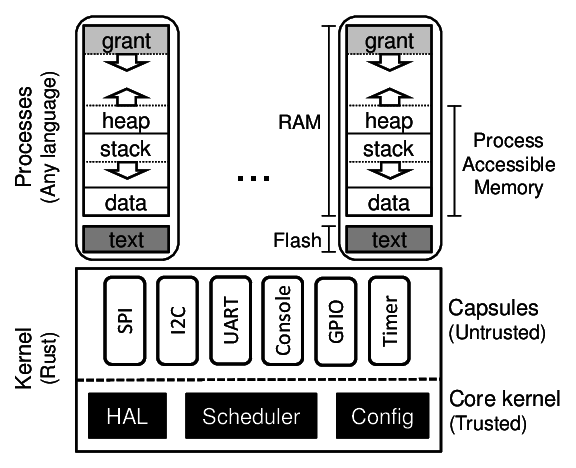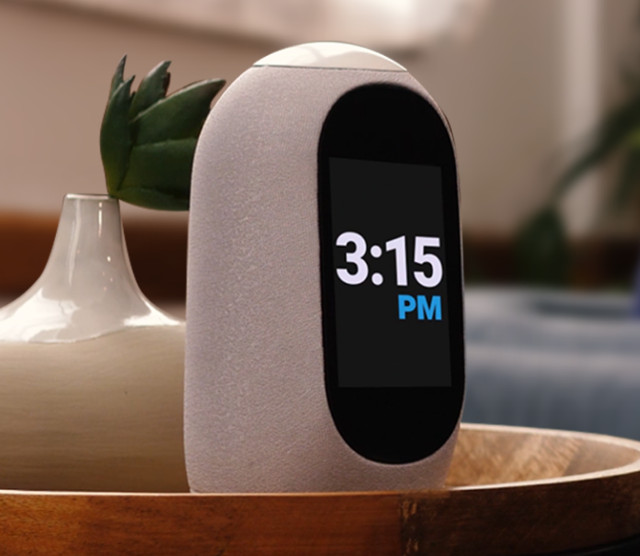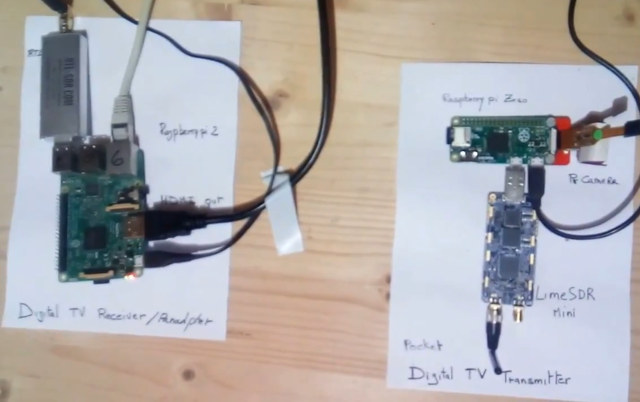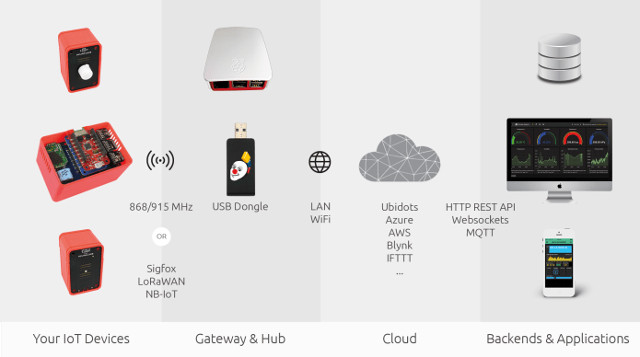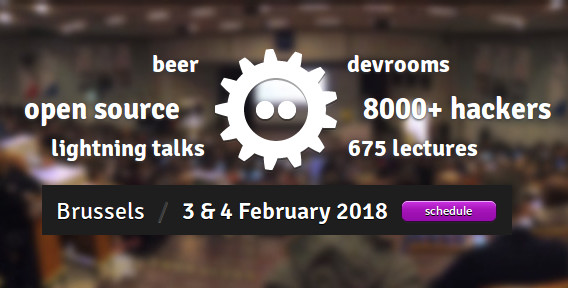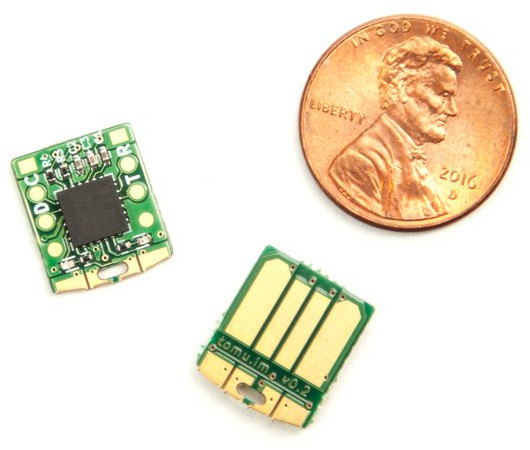We already have a fair share of open source operating systems running on Arm Cortex-M microcontrollers with FreeRTOS, mbed OS, Zephyr OS, RIOT, and many others. Earlier this morning, as I wrote about the Embedded Linux and IoT Summit 2018, I discovered you can now also add Tock to the list, with the operating system specifically designed for (secure) IoT on Arm Cortex-M MCUs. According to the abstract, Tock aims to enable more secure and extensible IoT systems by using a language sandbox and hardware enforced mechanism to isolate third-party and other untrusted code in the system. The operating systems is comprised of three components: A trusted core kernel written in Rust language with a HAL, scheduler and platform-specific configuration Capsules compiled with the kernel and use Rust’s type and module systems for safety; typically used for drivers & virtualization layers User-space processes using the MPU for hardware protection at runtime; […]
Embedded Linux Conference & IoT Summit 2018 Schedule
The Embedded Linux Conference 2018 and the OpenIoT Summit 2018 will jointly take place next month, on March 12 – 14, 2018 in Portland, Oregon, USA. The former is a “vendor-neutral technical conference for companies and developers using Linux in embedded products”, while the latter is a “technical conference for the developers and architects working on industrial IoT”. The Linux Foundation has already published the schedule, and it’s always useful to learn what will be discussed about even for people who won’t attend. With that in mind, here’s my own virtual schedule with some of the talks I find interesting / relevant to this blog. Monday, March 12 10:50 – 11:40 – Progress in the Embedded GPU Ecosystem by Robert Foss, Collabora Ltd. Ten years ago no one would have expected the embedded GPU ecosystem in Linux to be what it is now. Today, a large number of GPUs have […]
Open Source Software Releases – VLC 3.0 and Android-x86 7.1-r1
Two completely unrelated open source projects have released a stable version of their software this week, but instead of writing a post for each I’ll write about them in a single post. VLC 3.0 Vetinari VLC developers have just released version 3.0 – codenamed Vetinari – of the popular media player with new features such as ChromeCast support, and 8K video playback. Other highlights from the release include: Hardware decoding enabled by default to get 4K and 8K playback 10-bit and HDR support (only on Windows 10 Fall Creators Update for now) 360 video and 3D audio, up to Ambisoncics 3rd order Allows audio passthrough for HD audio codecs Can play Blu-Ray Java menus: BD-J Browsing of local network drives and NAS VLC 3.0 is also the first major version to be released for all platforms at the same time, and you can download VLC 3.0 for Windows, Mac OS […]
Mycroft Mark II Smart Speaker / Voice Assistant Works with Open Source Software (Crowdfunding)
Smart speakers have gain a lot of traction over the last few years, but many of the solutions are based on Google Assistant or Amazon Alexa voice services, with both companies likely tracking your voice searches the same way they track your online searches to provide a “personalized experience” and sell you products or server ads that match your interests. If you don’t like being tracked that way, a solution is to use an open source voice assistant such as Mycroft, and install it on a Linux computer, Raspberry Pi 3 board, or Android device. The company also introduced Mark I reference hardware platform based on Raspberry Pi 2 in 2015, and while all those hardware options should be fine for the technically inclined, but not really suited to the typical end user, and AFAIK they all lack a microphone array for better hot word detection. So Mycroft has come […]
Building a Compact Digital TV Transmitter with Raspberry Pi Zero, Pi Camera, and LimeSDR Mini USB SDR Board
There are few affordable standalone systems that allow you to transmit video over the air, and back in 2016, I had the chance to check out V-Bridge Muses-β MPEG-2/-4 encoder and DTV modular taking HDMI or composite video input. It was easy to use and worked fine, but it would still cost close to $600, and might have been a little smaller. Evariste Okcestbon has now created its own digital TV transmitter prototype, combining LimeSDR Mini USB SDR board with Raspberry Pi Zero board, and instead of supporting external input from HDMI or AV ports, he used an official Pi camera for video, and was able to transmit the video over a 1.2 GHz connection to a Raspberry Pi 2 with an RTL-SDR dongle, with the Pi 2 board also taking care of displaying the video signal. The full flow of transmission can be summarized as follows: Video from […]
BigClown is a Battery Powered Modular Wireless IoT Kit for Makers (Crowdfunding)
BigClown IoT Kit is designed to be as easy to use as building a castle from LEGO bricks or an IKEA cabinet. The open source kit is comprised of a coreboard module with STMicro STM32L0 Cortex M0+ micro-controller, and a sub GHZ (868/915MHz) radio for wireless communication, that accepts one or more compatible modules (currently ~30 different options), and communicate to a gateway such as Raspberry Pi or Turris Omnia where you’d connect BigClown RF USB dongle, although it’s also possible to include a Sigfox module for communication, and , LoRa & NB-IoT module appear to be planned. That’s for the hardware…The kit then connects to your chosen gateway via MQTT, which in turns accesses cloud services such as Ubidots, Microsoft Azure IoT, AWS, IFTTT, etc… , and you can monitor the data or control the kit through a web based dashboard or your own application. Core Module specifications: MCU […]
FOSDEM 2018 Open Source Developers Meeting Schedule
FOSDEM (Free and Open Source Software Developers’ European Meeting) occurs every year on the first week-end of February, where developers meet for two days discussing about open source software projects. FOSDEM 2018 will take place on February 3-4 this year with 652 speakers, 684 events, and 57 tracks, an increase over last year 608 speakers, 653 events, and 54 tracks. There will be 8 main tracks namely: Community, History, Miscellaneous, Performance, Python, Security and Encryption, Space, and Global Diversity CFP Day. There will also be 33 developer rooms, and since the full schedule is now available, I’ll make a virtual schedule mostly based on sessions from the Embedded, mobile, and automotive, Hardware Enablement, and Internet of Things devrooms. Saturday 3, 2018 09:50 – 10:15 – Turning On the Lights with Home Assistant and MQTT by Leon Anavi In this presentation you will learn the exact steps for using MQTT JSON […]
Tomu Arm Board Fits into a USB Connector, Adds Buttons, Two Factor Authentication to Your Computer (Crowdfunding)
We’ve covered many boards that claim to be the world’s smallest development board, and Tomu board does not claim anything like that, but it’s pretty small, as it’s made to fit into your computer’s USB board. It may be cool, but it could also potentially be useful, as the board exposes two (capacitive touch?) buttons, and two LEDs so you can use it as a computer accessory for example to add volume buttons, or as a Universal 2nd Factor (U2F) token supporting two-factor authentication (2FA) to login to compatible online services. Tomu board hardware specifications: MCU – Silicon Labs Happy Gecko EFM32HG309 ARM Cortex-M0+ up to 25 MHz with 64KB flash, 8KB RAM USB – 1x USB 2.0 FS port Misc – 2x buttons, 2x LEDs: 2 (red + green) Dimensions – 1.4mm thick (0.6mm thick PCB) Singapore based Sutajio Ko-usagi – the company behind the project – provides the […]


